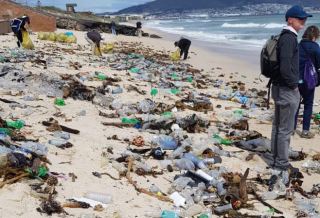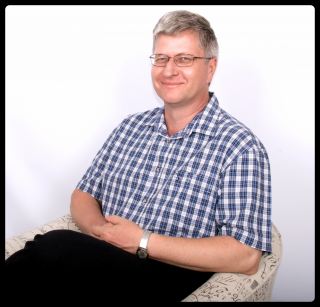Initiative to Capture Cape Town’s Trash Before it Hits the Coast
The City of Cape Town has joined key players and interested groups in the first of many meetings, to investigate ways to remove garbage from Cape Town’s rivers so it doesn’t make it into the ocean.
Included at the meeting were Plastics|SA, the South African Department of Environmental Affairs, Woolworths, The Percy Fitzpatrick Institute of African Ornithology, The Polyolefin Recycling Company (Polyco), Cape Town non-profit organisation Clean C, local digital marketing firm Gnu World Media and several other groups.
John Kieser, Sustainability Manager of Plastics|SA and facilitator at the meeting, says the main goal of this network will be to share information, ideas and resources for minimising the amount of litter that washes into the city’s seas.
Black River in Observatory is the first focus area. Already, Plastics|SA and the City of Cape Town’s Environmental Management Department have set up a system to remove litter floating on the river – 80 to 90% of which is plastic. A team gathers plastic at designated areas once or twice a week and takes it to Bokmakierie Primary School, where it’s separated and sent off for recycling.
In KwaZulu-Natal, the Department of Environmental Affairs is currently conducting similar projects, focusing on the Umgeni and three other rivers. If all goes to plan, the Department may consider funding similar Expanded Public Works Programme (EPWP) projects in Cape Town.
In the meantime, Kieser says the Cape Town network of groups will prevent people with the same vision – keeping our rivers and thus our oceans clean – from working in silos.
“It’s great that the plastics industry is facilitating this kind of dialogue,” says Gregory Player of NPO Clean C. With support from Cape Town-based digital marketing firm Gnu World, Clean C is working on a similar project – installing litter-catching nets over stormwater drains in the 4 kilometres between Sunset Beach and Milnerton Lagoon. Large amounts of household and general refuse – mostly plastic – washes into the lagoon from drains in areas including Joe Slovo, Sanddrift and Milnerton and then ends up on the beach and in the ocean.
The project would require a trained team of five to do regular clean-ups, and equipment like wheelie bins, uniforms, and a truck to transport the collected garbage.
Player says many EPWP projects run only in the short term and that most of the achieved improvements are lost once funding ends. “We’d like sponsorships to get the project off the ground – but once it’s implemented, we will move towards making it self-sustaining,” says Player.
Taryn Nightingale, PR and outreach specialist at Gnu World Media, says, “People forget that we form part of the same ecosystem the rivers, plants, oceans and animals do. We need to change how we view plastic and its value. When it’s recycled, there’s the opportunity to earn money from it, but when thrown away, it has grim consequences.
”Currently, only 5% of South Africans recycle. Mandy Naudé, CEO of Polyco, says the main reasons for this are a lack of education, incentive and infrastructure. “We must make it convenient for South Africans to recycle.” The organisation recently launched PACKA-CHING, which aims to increase recycling in informal settlements and lower-income areas. It has been running in Langa for about a year, and has resulted in the removal of about 240 000 kilograms of plastic since its inception.
Anyone interested in joining this network of plastic catchers or in helping in some way can contact John Kieser at This email address is being protected from spambots. You need JavaScript enabled to view it..
"Choking" on clean air goals a reality check
By Dr Martin van Nierop - Gondwana Environmental Solutions
South Africa is in danger of ‘choking’ in its bid to meet specific clean air goals, but failure to hit early targets may result in greater pragmatism and yet lead to air quality gains, according to Gondwana Environmental Solutions.
The environmental management services company has cautioned against “excessive pessimism” as the 10th anniversary of South Africa’s first declarations of priority areas for air quality management reveals no noticeable improvement in the targeted areas of the Vaal Triangle Airshed Priority Area (VTAPA), the Highveld Priority Area (HPA, including Ekurhuleni, Witbank, Middleburg and Secunda) and Waterberg-Bojanala Priority Area (including Lephalale, Rustenburg and Brits).Dr Martin van Nierop, co-founder of the Roodeport-based Gondwana Group, noted: “The priority areas were declared from November, 2007, under the Air Quality Act of 2004.
“Air quality readings differ according to the time of year, but monitoring by government and interested parties indicates no significant improvement while an in-depth report on the Highveld by one NGO suggests significant exceedances of permissible levels.“Therefore, toxic levels of air pollution continue to pose health risks in heavily industrialised areas. Clearly, more needs to be done. However, considerable progress has been made with the preparatory work that is essential if we are serious about clean air.
Build on these gains and significant improvement becomes possible.”He listed five ‘wins’:A robust legal framework is in place following the overhaul of South Africa’s air pollution legislation and the definition of National Ambient Air Quality Standards (NAAQSs)Representative stakeholder groups – “from polluters to pressure groups” – have been formed in the three priority areas Comprehensive air quality management plans (AQMPs) have been developed in each priority areaKnown industrial polluters are working on offset programmes to improve air quality while investigating a clean-up of their own processesWeaknesses in official monitoring and control have been identified. “While we are concerned about pollution, and need to improve urgently, excessive pessimism is unwarranted,” said Dr Van Nierop.
“If we’re pragmatic, we can move forward. Setbacks are often accompanied by gains.“For instance, the National Air Quality Officer has granted big polluters like Eskom and Sasol a postponement of their duty of compliance with the Air Quality Act, complicating the task of achieving clean air. But we now see major enterprises looking to fund offset programmes to cut pollution from non-industrial sources such as domestic cooking and heating, giving immediate health benefits to those most affected“Stakeholder groups and AQMPs give us the mechanisms to drive progress and maintain pressure on industrial groups. We have to be practical.
We can’t close down Eskom, Sasol and other big contributors to the economy, but we can co-opt them as contributors to the work of air quality improvement.”He believed the 10-year reality check shows that a strategic vision, like that of the Paris Agreement on climate change – signed by the South African government – must be accompanied by pragmatism and practical steps.
“In the present case,” said Dr Van Nierop, “we can see that monitoring and enforcement of air quality regulation by local authorities is inadequate. Municipalities either do not have the inspectors or their personnel lack the training and equipment to carry out inspections. Yet building official capacity is critical to priority area management processes.“It is therefore vital government make available funding and resources to local authorities so they can ensure compliance with AQMPs. Stakeholder groups can simultaneously keep awareness high and work with all interested parties to drive every possible improvement.
“To achieve clean air, we must clear every obstacle out the way, and we’ve made a start.”
Gondwana Environmental Solutions 011 472 3112 www.gondwanagroup.co.za
This email address is being protected from spambots. You need JavaScript enabled to view it. By GondwanaGroup|November 13th, 2017



